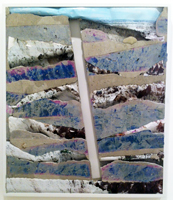One of a number of contemporary artists who are blurring the lines between photography and other mediums, Letha Wilson makes artworks that are as much sculptures as photographs. Amalgamations of photographic images and spray paint, lumber and concrete, these hybrid objects, medium sized and mostly wall hung, occupy territory also being explored by sculptors such as Rachel Harrison and Virginia Overton. An exhibition of new pieces (all from 2012) showcased Wilson’s adventuresome way with materials. As in the past, Wilson’s own color landscape photos formed the basis for each work. Wilson has described herself as an amateur photographer, and on their own, the pictures are indeed nothing special: vistas of mountains and deserts, indistinguishable from vacation photographs taken at any time over the last century, appear alongside inscrutable closeups of rocks, shrubs and trees. These nondescript outdoor shots are then subjected to various physical processes, including being pleated, cut, bisected by two-by-fours or partially obscured by flows of cement. Through such interventions, Wilson creates abstract approximations of each landscape’s most immediate visual and sensory effects. In Badlands White, crumpled photographs of Colorado’s badlands alternate with chunks of concrete that have been transfer-printed with images of the same rough country; the work’s ridges and gullies mimic the region’s inhospitable terrain. In the circular Storm Cloud Circle Fold (Colorado), a photograph (actually three conjoined photographs) of a spectacular thunderhead has been pleated to make a fan, its outward radiating lines conjuring the dizzying expanses of the American West’s big skies. More delicate are two views of barren salt flats, each partly obscured by a dried, semitransparent spill of salty-looking white Portland cement. The only floor piece is a narrow photograph, over 8 feet tall, of the Grand Tetons, pinned along its length between two halves of a tall, cast cement column. As in real life, one must tilt one’s head to see the image of a mountain peak that pokes out of the very top. Most abstract is 7he /fave Concrete Tondo, a disc of hardened cement, made by pouring concrete over a pleated photograph of a pink and red sandstone cliff. The photograph has transfer-printed onto the cement, resulting in horizontal bands of color that run against the grain of the sculpture’s vertical folds, just as they do in the live rock. Analogs for the physical reality of being in the landscape, Wilson’s altered photographs invest the pictured scenery certainly not the real thing, but no longer just a souvenir of past experience-with dimensionality and life.
Exhibition reviews
by Anne Doran
Letha Wilson
Art in America
4/1/2013

